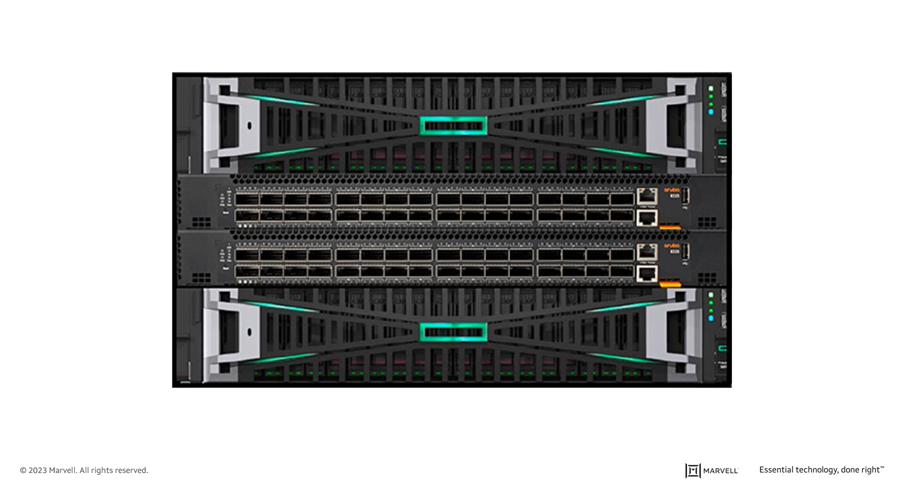

By Todd Owens, Field Marketing Director, Marvell
While Fibre Channel (FC) has been around for a couple of decades now, the Fibre Channel industry continues to develop the technology in ways that keep it in the forefront of the data center for shared storage connectivity. Always a reliable technology, continued innovations in performance, security and manageability have made Fibre Channel I/O the go-to connectivity option for business-critical applications that leverage the most advanced shared storage arrays.
A recent development that highlights the progress and significance of Fibre Channel is Hewlett Packard Enterprise’s (HPE) recent announcement of their latest offering in their Storage as a Service (SaaS) lineup with 32Gb Fibre Channel connectivity. HPE GreenLake for Block Storage MP powered by HPE Alletra Storage MP hardware features a next-generation platform connected to the storage area network (SAN) using either traditional SCSI-based FC or NVMe over FC connectivity. This innovative solution not only provides customers with highly scalable capabilities but also delivers cloud-like management, allowing HPE customers to consume block storage any way they desire – own and manage, outsource management, or consume on demand. HPE GreenLake for Block Storage powered by Alletra Storage MP
HPE GreenLake for Block Storage powered by Alletra Storage MP
At launch, HPE is providing FC connectivity for this storage system to the host servers and supporting both FC-SCSI and native FC-NVMe. HPE plans to provide additional connectivity options in the future, but the fact they prioritized FC connectivity speaks volumes of the customer demand for mature, reliable, and low latency FC technology.
By Todd Owens, Field Marketing Director, Marvell

Hewlett Packard Enterprise (HPE) recently updated its product naming protocol for the Ethernet adapters in its HPE ProLiant and HPE Apollo servers. Its new approach is to include the ASIC model vendor’s name in the HPE adapter’s product name. This commonsense approach eliminates the need for model number decoder rings on the part of Channel Partners and the HPE Field team and provides everyone with more visibility and clarity. This change also aligns more with the approach HPE has been taking with their “Open” adapters on HPE ProLiant Gen10 Plus servers. All of this is good news for everyone in the server sales ecosystem, including the end user. The products’ core SKU numbers remain the same, too, which is also good.
By Nick Ilyadis, VP of Portfolio Technology, Marvell
IoT devices, online video streaming, increased throughput for servers and storage solutions – all have contributed to the massive explosion of data circulating through data centers and the increasing need for greater bandwidth. IT teams have been chartered with finding the solutions to support higher bandwidth to attain faster data speeds, yet must do it in the most cost-efficient way - a formidable task indeed. Marvell recently shared with eWeek about what it sees as the top trends in data centers as they try to keep up with the unprecedented demand for higher and higher bandwidth. Below are the top eight data center trends Marvell has identified as IT teams develop the blueprint for achieving high bandwidth, cost-effective solutions to keep up with explosive data growth.
1.) Higher Adoption of 25GbE
To support this increased need for high bandwidth, companies are evaluating whether to adopt 40GbE to the server as an upgrade from 10GbE. 25GbE provides more cost effective throughput than 40GbE since 40GbE requires more power and costlier cables. Therefore, 25GbE is becoming acknowledged as an optimal next-generation Ethernet speed for connecting servers as data centers seek to balance cost/performance tradeoffs.
2.) The Ability to Bundle and Unbundle Channels
Historically, data centers have upgraded to higher link speeds by aggregating multiple single-lane 10GbE network physical layers. Today, 100Gbps can be achieved by bundling four 25Gbps links together or alternatively, 100GbE can also be unbundled into four independent 25GbE channels. The ability to bundle and unbundle 100GbE gives IT teams wider flexibility in moving data across their network and in adapting to changing customer needs.
3.) Big Data Analytics
Increased data means increased traffic. Real-time analytics allow organizations to monitor and make adjustments as needed to effectively allocate precious network bandwidth and resources. Leveraging analytics has become a key tool for data center operators to maximize their investment. 
4.) Growing Demand for Higher-Density Switches
Advances in semiconductor processes to 28nm and 16nm have allowed network switches to become smaller and smaller. In the past, a 48-port switch required two chips with advanced port configurations. But today, the same result can be achieved on a single chip, which not only keeps costs down, but improves power efficiency.
5.) Power Efficiency Needed to Keep Costs Down
Energy costs are often among the highest costs incurred by data centers. Ethernet solutions designed with greater power efficiency help data centers transition to the higher GbE rates needed to keep up with the higher bandwidth demands, while keeping energy costs in check. 
6.) More Outsourcing of IT to the Cloud
IT organizations are not only adopting 25GbE to address increasing bandwidth demands, they are also turning to the cloud. By outsourcing IT to the cloud, organizations are able to secure more space on their network, while maintaining bandwidth speeds.
7.) Using NVM Express-based Storage to Maximize Performance
NVM Express® (NVMe™) is a scalable host controller interface designed to address the needs of enterprise, data center and client systems that utilize PCI-e based solid-state drives (SSDs.) By using the NVMe protocol, data centers can exploit the full performance of SSDs, creating new compute models that no longer have the limitations of legacy rotational media. SSD performance can be maximized, while server clusters can be enabled to pool storage and share data access throughout the network.  8.) Transition from Servers to Network Storage With the growing amount of data transferred across networks, more data centers are deploying storage on networks vs. servers. Ethernet technologies are being leveraged to attach storage to the network instead of legacy storage interconnects as the data center transitions from a traditional server model to networked storage.
8.) Transition from Servers to Network Storage With the growing amount of data transferred across networks, more data centers are deploying storage on networks vs. servers. Ethernet technologies are being leveraged to attach storage to the network instead of legacy storage interconnects as the data center transitions from a traditional server model to networked storage.
As shown above, IT teams are using a variety of technologies and methods to keep up with the explosive increase in data and higher needs for data center bandwidth. What methods are you employing to keep pace with the ever-increasing demands on the data center, and how do you try to keep energy usage and costs down?
# # #
Copyright © 2025 Marvell, All rights reserved.

